 Anthony Dennis
Anthony Dennis
For full functionality of this site it is necessary to enable JavaScript. Here are the instructions how to enable JavaScript in your web browser.
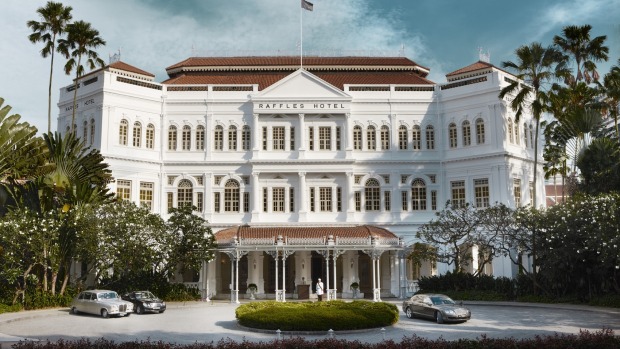
Every now and then, a traveller achieves a small victory that makes the not inconsiderable effort of travelling itself all the more worthwhile. Finally, for the first time, after a lifetime of visits to Singapore, I have arrived under the ornate wrought-iron portico for my brief stay at Raffles Singapore. I am poised to penetrate the seemingly impenetrable "House Guests Only" sign just outside the doors to the hotel.
I stride right by the formidable Sikh driveway commissionaires and straight into the resplendent lobby, which Joseph Conrad once described as being as "airy as a birdcage". I am officially a guest – or in Raffles-speak, a "resident" – of this most fabled of fabled hotels, opened at the height of British colonial rule in 1887, not a mere sticky-beak tourist as I have been on many occasions in the past, loitering around the environs of the hotel, pondering what it might be like to stay there.
Those impossibly tall and immaculately white-turbaned and robed Sikh doormen are a Raffles tradition in their own right, having welcomed - and for that matter unwelcomed - guests longer than even since the first Singapore Sling was shaken almost exactly a century ago. Of course, the strict entry rules are understandable since the lobby of the 103-room hotel, would be at risk of becoming as crowded as a Westfield on the last official shopping night before Christmas, should all and sundry be allowed in.
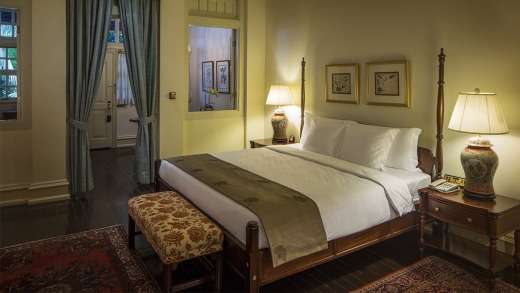
But you don't need to be house-guest, nay, resident to sample Raffles' signature tipple. I may have missed the hotel's 125th anniversary by a few years, but my brief visit does coincide with cocktail's 100th anniversary. Its creator, Ngiam Tong Boon, the head barman at the time, noting that British colonial etiquette frowned on women drinking in public, designed the cocktail - consisting of a gin, cherry brandy, Dom Benedictine, Cointreau, pineapple and lime juices with a dash of Angosturabitters and grenadine – so that it would present a distinctive rosy hue.
Such a colour gave the impression that the ladies of the time were drinking a fruit punch, not an alcoholic beverage. To mark the drink's centenary, in addition to actually ordering one, you can buy a special Singapore Sling 100th Anniversary Suite Package, attend a Singapore Sling Masterclass, buy a range of Singapore Sling merchandise from the gift shop and even enjoy a specially-created pink-coloured Singapore Sling (non-alcoholic) cake available at the essential high-tea just off the lobby. All good fun.
Nowadays, nobody is fooled by what that rosy hue conceals with Raffles itself representing a bit of a cocktail; a heady mixture of a well-maintained, well-protected "house-guest" inner-sanctum founded on impeccable service right down to the lowliest staff member with the main part of the hotel surrounded by a bevy of revenue-generating restaurants, bars and boutiques, where are all welcome.
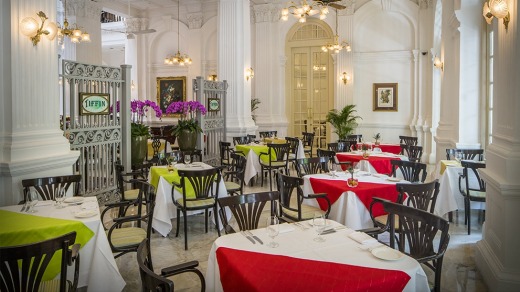
Certainly, it doesn't take long into a stay to realise that Raffles, which reopened in 1991 after a heroic restoration, is fuelled by tradition as much as a Singapore Airlines A380 is by Avgas. The hotel is one of the few, if only, such establishments anywhere to be classified a national monument, and the only one of which I'm aware that can maintain a themed public gift shop - complete with stuffed Raffles Sikh doormen dolls - roughly the size of a budget pharmacy back home.
Back in the inner-sanctum, I've scored a spacious courtyard suite, reached by walking along a breezy verandah with polished teak floorboards the colour of dark chocolate. My room comes complete with its own quaint parlour and period furnishings. It overlooks Raffles' precious palm-fringed and grassed open-space flanked by the almost blindingly white white-washed walls of the hotel which is nowadays crowded over on all sides by a huddle of towering skyscrapers.
Raffles was once true to its location - Beach Road - but it's now well-removed from the sea due to Singapore's unbridled hunger for reclamation. Of course, speaking of hunger, with a hotel of this stature comes a premium. I blush when I see that the steaks on the room service menu giddily start at about $100 while the most affordable room here at a hotel so famous it can name its price, starts at around the $700 mark.
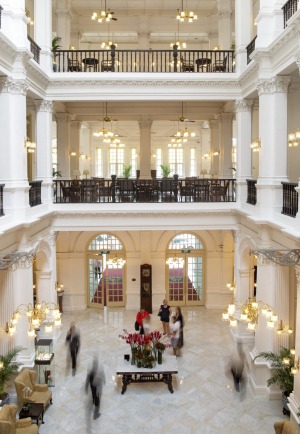
On TripAdvisor, it's all Slings and arrows, a litany of often petty guest complaints about everything from having been stopped from entering the lobby by an overly attentive Sikh doorman despite being a paying guest, to the curiously outdated television sets, sans flat-screens, heaven forbid, in at some of the rooms, including my own.
But, frankly, you don't come here to watch the telly, and I sympathise as much with the hotel as its guests. The Long Bar has been set so impossibly and utterly high over the years that Raffles cannot possibly win, though it still does manage to score the appropriate four and a half stars out of five on TripAdvisor.
As I wander the hotel, soaking up the colonial ambience so thick you could surely bottle it and flog it in the gift-shop, the nostalgia is all elegantly contagious. As befitting a national monument., Raffles is one of the few hotels to employ its own in-house historian, Leslie Danker. He is an elderly gentleman finally nearing retirement who for nearly half-a-century has worked at the hotel and who is in the process of handing over his archives and knowledge to a younger Raffles staff member, who will have no doubt been made familiar with hotel's photo gallery of the rich and famous who have stayed there.
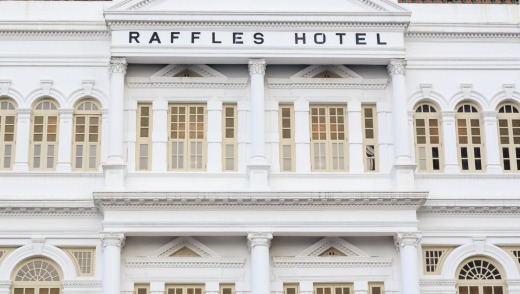
It occupies nearly all of one long wall in a discreet corner of the hotel near a backstage staff room. Somerset Maugham, Charlie Chaplin (photographed with his brother Syd), the Duke and Duchess of Cambridge, Karl Lagerfeld, Michael Jackson, Elizabeth Taylor, Noel Coward (the embodiment of the colonial hotel "resident"): they've all stayed here, and then some.
Now the hotel that strives more than most to keep the tourist riff-raff out for the sake of its paying guests, many of whom rightly view a stay here as much a rite of passage as somewhere to rest their heads for a night, is doing the near unthinkable. It's allowing public tours for non-residents, but only to mark the 50th anniversary of the city state's foundation, which falls on August 9, the island state's national day.
In fact, Raffles has become one of Singapore's most successful imports. The original Raffles is now an international brand, having spawned other hotels under its name from places as far removed as Istanbul and Siem Reap and Paris and Phnom Penh. But it's no cliche to declare there really is only one Raffles. If you've stayed at another Raffles - lovely as they are - you really haven't quite stayed at Raffles.
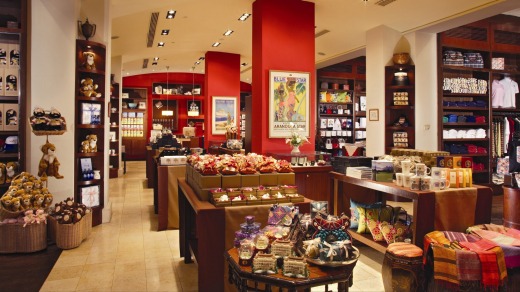
Elsewhere, those stately Sikh doormen - Narajan, Swaran and Sarjit - would surely have become subject to equal opportunity legislation, having to share their roles with other races and creeds. But without them, the hotel wouldn't be the same, even if on my next visit to Singapore I'll again be a mere tourist in Raffles' eyes, no doubt be staying elsewhere, and be summarily subject again to that "House Guests Only" sign.
raffles.com
nhb.gov.sg
Scoot operates daily services to Singapore from Sydney with connections to major Asian ports. From November 1 the low-cost airline will begin services to Singapore from Melbourne with five flights a week. Fares to Singapore start from $219, including taxes, one way from Sydney. Register online for regular sale fares updates. See flyscoot.com
Doubles at Raffles Singapore start from $740. 1 Beach Road, Singapore, phone +65 6337 1886. See website above.
Every Saturday until next month the public can join a 45-minute "Raffles Walk of Fame" tour four times a day (9am, 11am, 3pm and 5pm). The cost is $20 each.For bookings, email [email protected]